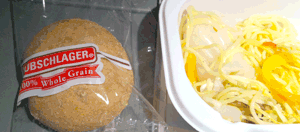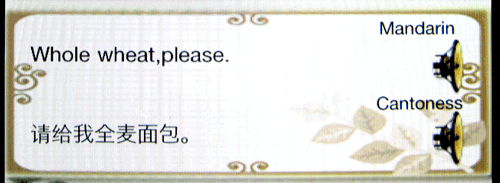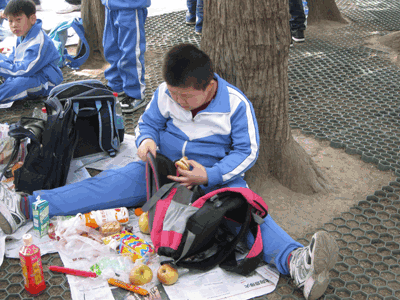Share This
This is the first of a few blogs we’ll be writing from Beijing, reporting on the whole grain scene here. Kara and I have arrived a few days early, to get our jetlag behind us before we participate in a Whole Grain Forum next week. In the meantime, I’m looking for clues everywhere, to learn whether whole grains have any foothold yet in China.
American Airlines served us a snack about ten hours into our flight. “Pizza or Chinese noodles?” the flight attendant asked, and of course I chose noodles to prepare for our descent into Beijing. Here’s what I got – totally refined noodles and vegetables, with a refined-wheat dumpling… and a whole grain roll, from WGC member Rubschlager Baking. Is this American Airlines’ idea of fusion cuisine, or do the Chinese like a good 100% whole grain roll with their noodles? No idea. (Sorry about the photo quality. An iPhone in an airline cabin isn’t ideal!)
As the lights of Beijing began to appear miles below me, I spent a few minutes exploring the new apps my thoughtful husband had stuck on my iPhone as I was packing for this trip. One of them, called Eating in China, included an electronic phrasebook to help me order food in restaurants. Much better than those paper phrasebooks, where you have to figure out how to pronounce the words once you find them – with Eating in China, you scroll around, find the phrase you want, then press the Mandarin button, and the phone says the key phrase.
Let’s see… here’s “Do you have a menu in English?” I think if they have one, they’ll take one look at my face and offer it to me. “This is not what I ordered.” Could be handy, but I’m not sure I’ll really know what I’ve ordered. “Where can I get a knife and fork?” That’s for wimps. I can use chopsticks just fine.
Whoa! “Whole wheat, please.” Now there’s a phrase that will come in handy. There’s hope that whole grains have some kind of presence in China, if this one’s included in the app. Eating in China was created by MEET Studios in Chengdu, and I have to assume they know what’s possible in their own country. I think I need to send those folks a Just Ask for Whole Grains button to recognize their good work.
Once we landed, I was stuck in the usual endless customs line that exists in every country, and struck up a conversation with a Chinese ex-pat who came to the U.S. to get her Masters and PhD in mechanical engineering, and stayed to become an American citizen working for Texas Instruments. She comes back to China regularly, and stays in touch with family and friends between visits. She told me there’s some knowledge of the health benefits of whole grains among more educated people, but it’s an uphill fight to promote whole grains. “When I grew up in China, we had whole grain bread most of the time, and it was a big deal to have white bread about once a week. It was very expensive and special. So now China is more prosperous and everyone thinks they’ve made it, financially, if they can have white bread all the time.”
China has arrived financially. I haven’t been here in ten years, and the changes are phenomenal. Most of them are very positive: new subway lines, cleaner streets, new buildings, and free broadband in my hotel so I can post this blog! But KFC, Subway, Baskin Robbins and McDonald’s are on every corner, and the Chinese also produce plenty of their own junk food these days. This boy, on a school field trip to the Summer Palace today, exemplifies what’s happening to Chinese health.
Last year, the New England Journal of Medicine reported that diabetes in China now affects 9.7% of people over age 20, just short of the U.S. rate of 10.7%. It’s estimated that 92 million people have diabetes, with another 148 million having pre-diabetes. That’s why Chinese nutrition authorities, determined to stem rising rates of obesity and diabetes, are holding this Whole Grain Forum next week to promote increased consumption of whole grains. Stay tuned, as we learn more. (Cindy)




Add a Comment